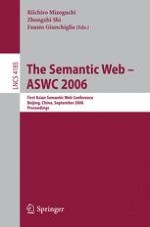2006 | Book
The Semantic Web – ASWC 2006
First Asian Semantic Web Conference, Beijing, China, September 3-7, 2006. Proceedings
Editors: Riichiro Mizoguchi, Zhongzhi Shi, Fausto Giunchiglia
Publisher: Springer Berlin Heidelberg
Book Series : Lecture Notes in Computer Science
